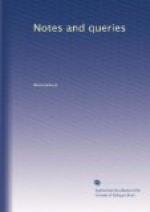J. MILNER BARRY.
Totnes, Feb. 21. 1850.
* * * * *
WHAT IS THE MEANING OF “LAERIG?”
This query, evidently addressed to our Anglo-Saxon scholars by the distinguished philologist to whom we are all so much indebted, not having been hitherto replied to, perhaps the journal of “NOTES AND QUERIES” is the most fitting vehicle for this suggestive note:—
TO DR. JACOB GRIMM.
Allow me, though an entire stranger to you, to thank you for the pleasure I have derived, in common with all ethnological students, from your very valuable labours, and especially from the Geschichte der Deutschen Sprache. At the same time I venture, with much diffidence, to offer a reply to your question which occur in that work at p. 663.:—“Was heisst laerig?”
Lye says, “Haec vox occurrit apid Caedm. At interpretatio ejus minime liquet.” In the Supplement to his Dictionary it is explained “docilis, tyro!” Mr. Thorpe, in his Analecta A.-S. (1st edit. Gloss), says, “The meaning of this word is uncertain: it occurs again in Caedmon;” and in his translation of Caedmon he thus renders the passage:—“Ofer linde laerig=over the linden shields.” Here then laerig, evidently an adjective, is rendered by the substantive shields; and linde, evidently a substantive, is rendered by the adjective linden. In two other passages, Mr. Thorpe more correctly translates lindum=bucklers.
Lind, which Lye explained by the Latin labarium, vexillum, that excellent scholar, the late lamented Mr. Price, was the first, I believe, to show frequently signified a shield; which was, probably for lightness, made of the wood of the lime tree, and covered with skin, or leather of various colours. Thus we have “sealwe linde” and “hwite linde” in Caedm., “geolwe linde” in Beowulf.
All this is superfluous to you, sir, I know—“Retournons a nos moutons,” as Maistre Pierre Pathelin says.
The sense required in the passage in Brythnoth seems to me to be:—
“baerst bordes laerig=the empty (hollow concave) shields
“and seo byrne sang=and the armour (lorica) resounded.”
And in Caedmon:—
“ofer linde laerig=over the empty (hollow concave) shield.”
In Judith, Th. Anal. 137, 53. we have a similar epithet:—
“hwealfum lindum=vaulted (arched concave) shields.”
We should remember that Somner has ge-laer, void, empty, vacuus; and Lye, with a reference to the Herbarium, laer-nesse, vacuitas. In the Teuthonista we have laer, vacuus, concavus. In Heiland, 3, 4. “larea stodun thar stenuatu sehsi=_empty_ stood there stone-vats six.” I need not call to your mind the O.H.G. lari.




